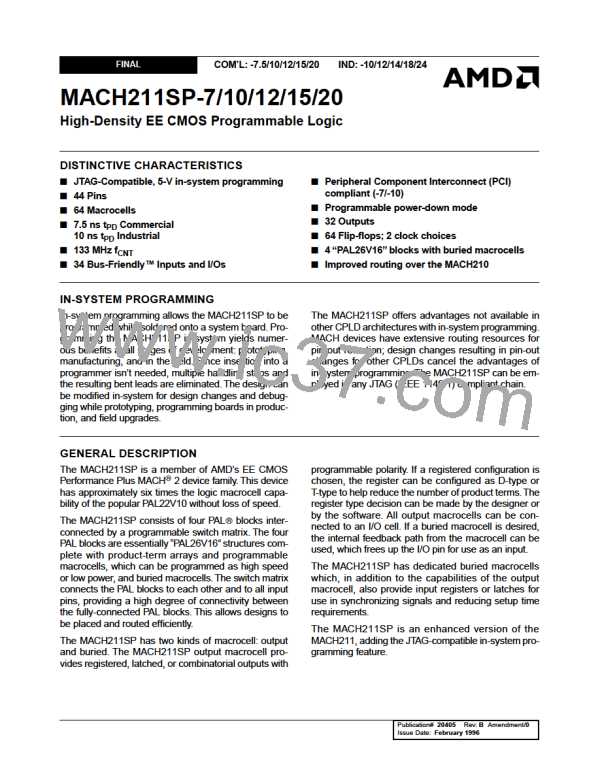These choices make it possible to use the macrocell as
an output, an input, a bidirectional pin, or a three-state
output for use in driving a bus.
should be programmed. The configuration file is dis-
cussed in detail in the MACHPRO software manual.
The MACH211SP devices tristate the outputs during
programming.They have one security bit which inhibits
program and verify.This allows the user to protect pro-
prietary patterns and designs.
Power-Down Mode
The MACH211SP features a programmable low-power
mode in which individual signal paths can be pro-
grammed as low power. These low-power speed paths
will be slightly slower than the non-low-power paths.
This feature allows speed critical paths to run at maxi-
mum frequency while the rest of the paths operate in
the low-power mode, resulting in power savings of up
to 75%. If all signals in a PAL block are low-power, then
total power is reduced further.
Program verification of a MACH device involves read-
ing back the programmed pattern and comparing it with
the original JEDEC file. The AMD method of program
verification performed on the MACH devices permits
the verification of one device at a time.
Accidental Programming or Erasure
Protection
In-System Programming
It is virtually impossible to program or erase a MACH
device inadvertently. The following conditions must be
met before programming actually takes place:
Programming is the process where MACH devices are
loaded with a pattern defined in a JEDEC file obtained
from MACHXL software or third-party software. Pro-
gramming is accomplished through four JTAG pins:
Test Mode Select (TMS), Test Clock (TCK), Test Data
In (TDI), and Test Data Out (TDO). The MACH211SP
can be employed in any JTAG (IEEE 1149.1) compli-
ant chain. While the MACH211SP is fully JTAG com-
patible, it supports the BYPASS instruction, not the
EXTEST and SAMPLE/PRELOAD instructions. The
MACH211SP can be programmed across the commer-
cial temperature range. Programming the MACH de-
vice after it has been placed on a circuit board is easily
accomplished. Programming is initiated by placing the
device into programming mode, using the MACHPRO
programming software provided by AMD. The device is
bulk erased and the JEDEC file is then loaded. After
the data is transferred into the device, the PROGRAM
instruction is loaded. Further programming details can
be found in application note, “Advanced In-circuit
Programming Guidelines.”
■ The device must be in the password-protected
program mode
■ The programming or bulk erase instruction must be
in the instruction register
If the above conditions are not met, the programming
circuitry cannot be activated.
To ensure that the AMD ten year device data retention
guarantee applies, 100 program/erase cycle limit
should not be exceeded.
Bus-Friendly Inputs and I/Os
The MACH211SP inputs and I/Os include two inverters
in series which loop back to the input. This double
inversion reinforces the state of the input and pulls the
voltage away from the input threshold voltage. For an
illustration of this configuration, please turn to the
Input/Output Equivalent Schematics section.
On-Board Programming Options
PCI Compliance
Since the MACHPRO software performs these steps
automatically, the following programming options are
published for reference.
The MACH211SP-7/10 is fully compliant with the PCI
Local Bus Specification published by the PCI Special
Interest Group. The MACH211SP-7/10’s predictable
timing ensures compliance with the PCI AC specifica-
tions independent of the design. On the other hand, in
CPLD and FPGA architectures without predictable tim-
ing, PCI compliance is dependent upon routing and
product term distribution.
The configuration file, which is also known as the chain
file, defines the MACH device JTAG chain.The file con-
tains the information concerning which JEDEC file is to
be placed into which device, the state which the out-
puts should be placed, and whether the security fuses
8
MACH211SP-7/10/12/15/20

 AMD [ AMD ]
AMD [ AMD ]